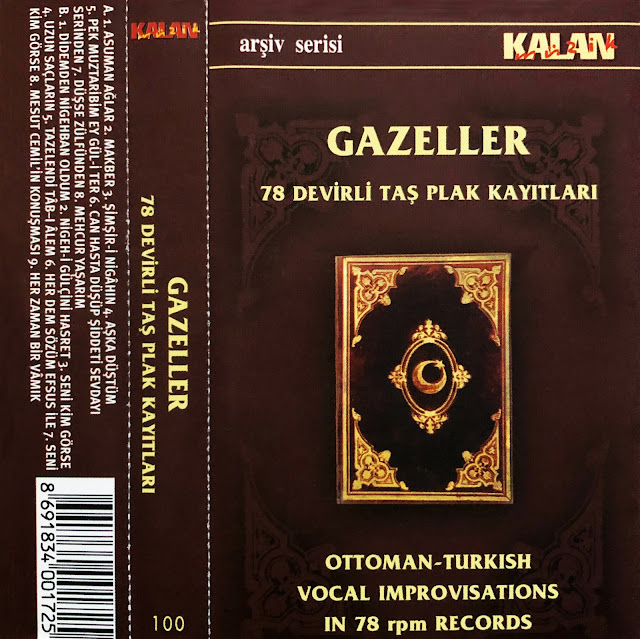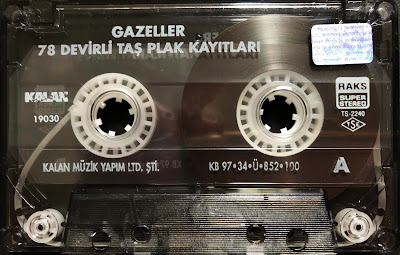Gazeller I – Ottoman-Turkish Vocal Improvisations in 78 RPM Records – Kalan Müsik 19030 (Cassette)
This cassette on the Turkish Kalan label presents a choice selection of traditional Gazel vocal improvisations recorded on shellac 78 RPMs between the early 1910s and the 1930s. The Turkish/Ottoman version of Ghazal poetry, which originated in Arabia in the 7th century, was a spiritual and metaphorical art form connected to Sufism that expressed “Divine Love.”
Following our post of the Gazeller II cassette, the music on Gazeller I here features great Gezal masters, accompanied by ud lute, violin or ney flute, including Hafiz Kemal (A1, A3, B2), Hafiz Burhan (A2) Hafiz Sadettin Kaynak (A4, A7), A Celal Tokses (A5, A8), Hüseyin Hüsnü Bey (A6), Bursali Hamid Dikses Bey (B1), Hafız Sami Efendi (B3), Hafız Ahmet Bey (B4), Bahriyeli Sehab (B5), Hafız Aşir Efendi (B6), Hafız Yaşar (B7), Mesut Cemil (B8) and Hafız Osman & Mesut Cemil (B9).
Gazeller II – Ottoman-Turkish Vocal Improvisations in 78 RPM Records here
Photographs below are from Falnama: The Book of Omens by Massumeh Farhad & Serpil Bagci, Thames & Hudson, 2009, and the Istanbul University Library:
“At first glance, this composition recalls images of the ‘Hand of Fatima,’ the Prophet Muhammad’s daughter and Imam Ali’s wife. A popular and ubiquitous symbol throughout the Islamic world, it has long been associated with talismanic and healing properties. In the related Falnama text, however, the illustration is identified as ‘Ali’s Khaybar-conquering palm,’ which refers to the Imam’s celebrated conquest of the fortress in 629.”
Ottoman astronomers at work around Taqī al-Dīn (1526-1585) – an Ottoman polymath presumably on the right of the astrolabe here – at the short-lived Istanbul Observatory built in 1577 and destroyed in 1580 under suspicion of impious astrological investigations.
The painting is from Shahinshah-nama (History of the King of Kings), an epic poem by 'Ala ad-Din Mansur-Shirazi, written in honor of Sultan Murad III (reigned 1574-1595):
Please help me purchase important traditional records to pursue my global
curation project and share the best finds with you on this blog:







Thank you very much
ReplyDelete